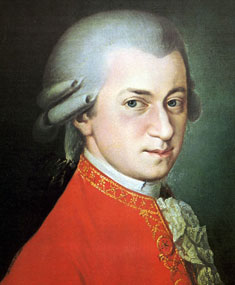

Wolfgang Amadeus Mozart (1756-91) composed Ave Verum Corpus, K. 618 in 1791. Mozart was one of the most influential composers during the Classical period. He wrote over 600 musical works, and excelled in composing all of the major genres of music popular during his era such as opera, orchestral music, chamber and solo instrumental music, songs and sacred vocal music.
Mozart was born in 1756 in Salzburg, and was taught music by his father, Leopold, a violinist and composer. Wolfgang was a musical prodigy, and began composing and performing publicly from the age of six. His father took him on performance tours throughout Europe, and Mozart not only had the opportunity to play before wealthy patrons and nobility in cities such as Paris, London and Munich, but he also was exposed many different forms of music in his travels (these experiences contributed to Mozart’s mastery of a wide variety of styles in his compositions).
Mozart did not choose to follow the traditional, patronage system career path taken by most musicians during this era, thus he did not seek an appointment as a composer to a wealthy patron. Although he worked for a number of years for the Archbishop of Salzburg, Mozart felt the patronage system was too restrictive, and he moved to Vienna in 1781 to pursue a musical career on his own. In 1782, he married Constanze Weber, a singer, and they had six children. Mozart was well-received as a musician in Vienna, and he earned a living by teaching, giving concerts, procuring commissions for his music, publishing his music, and later in his career, as a court musician to the Hapsburg court. However, Mozart and his wife were unable to manage finances well, and as a result, they were frequently in debt. Mozart died from rheumatic fever on December 5, 1791. [1]
Ave Verum Corpus is a short, sacred work composed by Mozart in 1791 for the feast of Corpus Christi. Mozart composed this piece six months before his death. The musical form is a motet. A motet is often defined as a vocal piece with a sacred text, musically composed in the style of the period. The musical form of motet has evolved throughout music history. During the 13th-15th centuries, motets were sacred, unaccompanied choral works, often based on a preexisting melody and text. New melodies were then added to the preexisting melody, usually in counterpoint. Beginning in the 16th century, the preexisting melody frequently was secular. Mozart scored his Ave Verum Corpus for chorus, strings and continuo.
TECHNIQUE TIPS: Mozart’s Ave Verum Corpus motet has a homophonic texture (a form of musical texture with a melody and chordal accompaniment), and although the piece is only 45 measures long, the music evokes a simple, yet sublime mood. Mozart indicated the tempo of this piece should be adagio, meaning a slow, leisurely tempo should be used. Utilize smooth, flowing bows to play the peaceful and soaring melody of this lovely motet.
© Copyright 2025 RK Deverich. All rights reserved.
Although this online viola class is provided free of charge, all rights are reserved and this content is protected by international copyright law. It is illegal to copy, post or publish this content in any form, and displaying any of this material on other websites, blogs or feeds is prohibited. Permission is given for individual users to print pages and perform music from this website for their personal, noncommercial use.